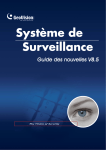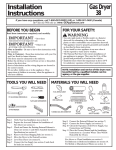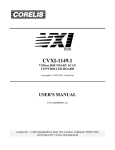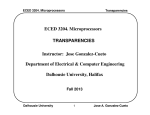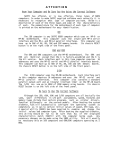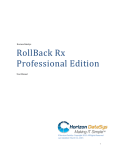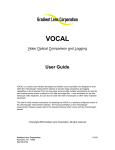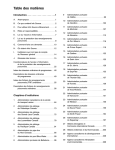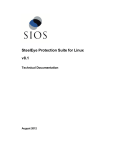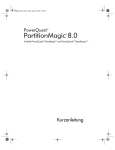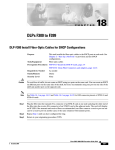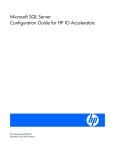Download Adexer Manual 202KB Jun 13 2015
Transcript
USERS MANUAL
BY MARTIN EBERHARD
14 OCTOBER 2014
Revision History
Adexer Manual
Rev.
Rev.
Date
Author
Notes
1.00
6 Oct
2013
M.
Eberhard
Created - untested revision
1.01
26 Feb
2014
M.
Eberhard
More verbose. Add TW command. Test controller
test functions.
1.02
27 Feb
2014
M.
Eberhard
Add the following commands: CC, EU, FD, HD, HL,
ST, SE E=, SE O=. Split up help screens. Test
read, write, format routines
1.03
5 Mar
2014
M.
Eberhard
Add DC command. Failed to get Track Offsets
working
1.04
7 Mar
2014
M.
Eberhard
Fix various bugs, Add format and verify options
to DC command. Rename FD to be FS, and create FD
command. Add XD and XL commands. More verbose on
SR, SW, CR, CW, etc. Track offsets still don't
work.
1.05
19 Mar
2014
M.
Eberhard
Fix bug in disk copy text. Allow platter to be
specified in the XD and XL commands. Change ?R to
?D. Add /P options. Disabled track offsets until
I can figure out how to fix them.
19 Mar
2014
M.
Eberhard
Original manual release
1.06
24 Mar
2014
M.
Eberhard
Set up stack before any subroutine calls :-)
1.07
14 Apr
2014
M.
Eberhard
Fix variable-clear loop in main
1.08
24 Apr
2014
M.
Eberhard
22 May
2014
M.
Eberhard
Document CP/M version. Add Revision History.
10 Jun
2014
M.
Eberhard
Fix Restore bug in XL
x
19 Aug
2015
M.
Eberhard
Support 88-2SIO port B and 88-SIO for XModem file
transfers
1.11
X
29 Aug
2014
M.
Eberhard
Improve Debugging the Disk Drive section of
manual, based on new experience. Default track
verify mode off. Improve instructions in TI
command. Add MS command.
1.12
X
10 Sep
2014
M.
Eberhard
Add comments about loose voicecoil wires, etc.
Improved accuracy on time measurements. Track
offsets working!
M.
Eberhard
Add note about making spindle transducer
alignment tool. Change references to match 1978
Pertec manual#104630. Fix bug counting errors.
Perform a dummy read after seeking, to re-select
the desired platter and head.
X
X
1.09
1.10
1.13
X
8 Oct
2014
Fix bugs with fill data & verify, in FD and FS
commands. Fix bug when exiting XL command with
short disk file.
CONTENTS
Introduction ......................................................... 3
Documentation Requirements ......................................... 3
Tools .............................................................. 3
Section 1: Adexer .................................................... 4
System Requirements ................................................ 4
Loading Adexer ..................................................... 5
Getting Started .................................................... 6
Adexer Commands .................................................... 7
Adexer State Commands ............................................ 7
Memory Buffer Commands ........................................... 8
Controller Commands .............................................. 9
Disk Positioner Commands ........................................ 13
Disk Read/Write Commands ........................................ 14
Other Commands .................................................. 17
Section 2: Suggested Testing Procedures ............................. 19
Debugging the Controller .......................................... 19
Power Supply Checkout ........................................... 19
Processor Card RAM Test ......................................... 19
Processor IV Bus Test ........................................... 19
Interface Card Initial Validation ............................... 19
Disk Data Card Validation ....................................... 19
FIFO Validation ................................................. 20
Debugging the Disk Drive .......................................... 20
Before you ever power-on the disk drive ......................... 20
Power Supply Checkout ........................................... 26
Servo Adjustments ............................................... 27
Head Alignment .................................................. 30
Other Adjustments ............................................... 31
Section 3: Supplemental Datakeeper Documentation .................... 32
Disk Controller Commands .......................................... 32
Error Codes ....................................................... 33
IV Byte Functions ................................................. 34
Altair - Datakeeper Interface Signals ............................. 35
Section 4: Boot Loader .............................................. 36
Adexer
13 September 2014
1
2
Adexer
13 September 2014
INTRODUCTION
Adexer, the Altair Datakeeper Exerciser, is a comprehensive
program for testing and servicing the MITS Altair 88-HDSK
Datakeeper Hard disk subsystem. It includes functions that allow
fairly thorough testing of the Datakeeper controller, as well as
functions that allow control and testing of the disk drive.
Adexer performs all of the functions necessary to tune the disk
drive positioner servo and to align the read/write heads,
thereby replacing the Pertec disk exerciser.
Adexer can also format, copy, and verify disks, as well as
upload and download complete disk images, using the XModem
protocol.
Adexer can be assembled to run either stand-alone in an Altair,
or under CP/M, with a single assembly-time switch.
DOCUMENTATION REQUIREMENTS
You will need the following additional documents:
1. Pertec Operating and Service Manual. You can use any of the
following. However, section references in this document refer
to the first one.
•
•
•
Pertec Operating
D3300/D3400 Disk
Pertec Operating
D3300/D3400 Disk
Pertec Operating
D3000 Disk Drive
and Service Manual Number 104630, Models
Drives
and Service Manual Number 104615, Models
Drive with Diablo Compatible Interface
and Service Manual Number 103715, Model
with Diablo Compatible Interface
2. Altair Hard Disk (88-HDSK) Preliminary Documentation
TOOLS
In addition to Adexer, you will need the following tools:
1. A decent 2-channel oscilloscope, at least 100 MHz
2. An accurate digital voltmeter
3. Screwdrivers, Allen Wrenches, wire cutters, needle-nosed
pliers, small box wrenches, etc.
4. Soldering iron, de-soldering tool, good solder, etc.
5. A 50-pin loop-back cable. described later in this document
6. Several 12” to 16” jumper cables with hook-type ends
7. Mylar measurement shims, 0.05”
8. A 14-pin DIP header, to make an Emergency Unload Bypass Jumper
9. Lint-free cleaning wipes, cotton swabs, masking tape
10. 99% isopropyl alcohol and Windex
Adexer
13 September 2014
3
SECTION 1: ADEXER
SYSTEM REQUIREMENTS
Adexer is designed to run in a “standard” Altair computer:
1. An Altair 8080-based computer (8800, 8800a, 8800b, or 8800Bt),
or an equivalent computer with a 2 MHz 8080 CPU.
2. At least 16K-bytes of available zero wait-state RAM, starting
at address 0. If you are running under CP/M, then you must
have a 16K or larger version of CP/M.
3. In the stand-alone mode, an MC6850-based serial port, at
address 10h. (This is the standard Altair Terminal port.)
Compatible serial ports include the 88-2SIO, the 88-UIO, and
the 8800b Turnkey Module. (If assembled to run under CP/M,
then Adexer will use the CP/M Console port instead.)
4. A terminal or Teletype, connected to the above port.
5. A second serial port, required only for uploading and
downloading disk images. If your Terminal port is port A an
88-2SIO, then port B on that board is suitable (and can also
be used for loading Adexer). If your Terminal port is on an
88-UIO or 8800b Turnkey Module, then you can use an 88-SIO
addressed at the standard address for an 88-SIO, 00h-01h.
6. Two MC6820-based parallel ports at addresses A0h and A2h.
Compatible parallel ports include the 88-4PIO, or two 88-PIOs.
(These ports are the standard Datakeeper interface.)
7. A complete 88-HDSK Datakeeper subsystem, with the controller,
the disk drive, and all necessary cabling, connected to the
above parallel ports.
8. At least one good, clean 24-sector disk cartridge for the
Pertec drive.
4
Adexer
13 September 2014
LOADING ADEXER
You can load Adexer several ways:
1. Load the stand-alone version of Adexer from paper tape or
cassette tape using the following Bootstrap Loader program.
a. Enter the following program via the front panel. (Select
the appropriate column to load from either 2SIO port.)
Octal
Address
000
001
002
003
004
005
006
007
010
011
012
013
014
015
016
017
020
021
022
023
024
025
026
027
030
031
032
033
88-2SIO
Port 0
Octal Data
076
003
323
020
076
025
323
020
041
302
077
061
032
000
333
020
017
320
333
021
275
310
055
167
300
351
013
000
88-2SIO
Port 1
Octal Data
076
003
323
022
076
025
323
022
041
302
077
061
032
000
333
022
017
320
333
023
275
310
055
167
300
351
013
000
Mnemonic
MVI A,ARESET
Comment
ACIA Reset command
OUT ACTRL
reset ACIA
MVI A,AINIT
Initialize ACIA
OUT ACTRL
LXI H,LADDR
End of checksum loader
LXI SP,STACK
for the returns
IN
Get ACIA status
ASTAT
RRC
RNC
IN
ADATA
Rx Data Available is bit 0
Loop if no data available
Read ACIA data
CMP L
RZ
DCR L
MOV M,A
RNZ
PCHL
Is it a leader byte?
Yes: loop back to 013
Next addr, set Z if done
Write data to memory
Loop if not done
Go execute the loaded code
Stack for above returns
b. Reset, and examine address 0.
c. Set the sense switches (A15:18) to 00000000b to load from
2SIO Port 0, or 00000110b to load from 2SIO Port 1.
d. Run.
2. Load the stand-alone version of Adexer from paper tape or
cassette tape using the MBL or MBLe PROM. Follow the PROM
loader’s directions for loading.
3. Load the CP/M version of Adexer by typing ‘ADEXER’ at the CP/M
prompt.
Once Adexer is loaded, you can type ‘?’ to see an initial help
screen.
Adexer
13 September 2014
5
GETTING STARTED
Most of Adexer commands require the following:
1. The Interface Card must be installed in the Controller.
(Limited testing is possible with just the Controller’s
Processor Card installed.)
2. Some of the Adexer testing functions require you to disconnect
all disk drives from the controller. If no disk drives are
connected to the Interface Card, then a jumper must be
temporarily installed on the Interface Card from the + lead of
capacitor C3 to the + lead of capacitor C8. (Be careful - the
orientation of these two capacitors on the board is not the
same.) This jumper applies +5 volts to the termination
resistor network for the disk drive interface. (Normally, the
disk drive provides this +5 volt supply.) With the termination
resistor network powered, the four “Busy Seeking” signals
become False, allowing the controller’s initialization routine
to complete.
3. If no disk drives are connected to the Interface Card, then a
another jumper must be temporarily installed on the Interface
Card from Ready to Ground (Pin 27 to pin 28 on connector P2)
(This makes the drive appear ready, so that Adexer commands
that use the controller’s Read Status command will complete.)
6
Adexer
13 September 2014
ADEXER COMMANDS
Adexer commands are entered on a command line on the Altair’s
Terminal. Adexer prints a prompt (‘%’) when it is expecting a
command. Adexer prints results on the Terminal in a simple text
form that is compatible with any kind of terminal - even a
Teletype. Most commands that might run for a long time may be
interrupted by typing ‘Q’ on the Terminal.
Many commands include variables, abbreviated with angle braces,
from the following table.
Field
Unit
Buffer
Platter(1)
Side (2)
Sector
Cylinder Address
IV Byte Address (3)
Abbrev. Minimum Maximum
<U>
<B>
<P>
<S>
<C>
<I>
1
0
0
0
0
0
0
4
3
3
1
23
405
255
Format
Decimal
Decimal
decimal
Notes:
1. Platter 0 is the removable cartridge. For the normal 88-HDSK
(with a Pertec 3422 drive), the single fixed platter is platter
1. For larger Pertec drives, the extension platters are 2 and 3.
2. Side 0 is the top side of the platter; side 1 is the bottom.
3. Not all IV Byte addresses exist. Reading a nonexistent IV byte
returns FFh. Writing a nonexistent IV byte has no effect.
ADEXER STATE COMMANDS
?S
Help with Adexer State Commands
SE
Display current settings and state. Note that this command
will overwrite Controller buffer 3. <LIST>
SE A={0/1} Set Automatic Seek Mode Off/On. This affects the SK
and ST commands. When off, you must press the space bar
seek to each listed track. When on, seeking is automatic.
The default is off.
SE E={0/1} Set Hex Load Echo Mode (for HL command) Off/On. If
Echo is on, then about 5 mS delay will be required between
characters during a hex load, at 9600 baud.
SE O={-/0/+/G} Set Track Offset. Subsequent disk read operations
(DC, DV, SB, SR, and XD) and seek commands (SK and ST) will
be done with the track offset slightly outward if O=-, or
inward if O=+. These track offsets are useful for margin
testing, and for reading a marginal platter. O=0 selects no
offset. O=G sets the read amplifier for reduced gain, which
Adexer
13 September 2014
7
is useful for margin testing. For verify operations, the
offset applies only to the source disk. The default is 0.
Track offset setting does not affect disk writes - these
are always performed with the offset set to 0.
SE P=<P> Set current platter number. <P> is between 0 and 3.
Platter 0 is the removable cartridge. Platter 1 is the
fixed disk in a normal Datakeeper. Platters 2 and 3 are
extension platters for larger Pertec drives. The default is
0. This command actually selects the specified platter by
performing a sector read, which overwrites controller
buffer 3. The sector read is not checked for any errors.
SE S={0/1} Set the current platter side, where 0 means the top
side. The default is 0. This command actually selects the
specified side by performing a sector read, which
overwrites controller buffer 3. The sector read is not
checked for any errors.
SE T={0/1} Set track verify mode Off/On. This affects the SK and
ST commands. When On, the disk is read and the track number
found on the disk is compared to the expected track number,
generating an error report if not the same. When Off, disk
header errors are ignored. The default is off.
SE U=<U> Set the current unit. <U> is between 1 and 4. The
default is 1.
SE V={0/1} Set Verbose Seek Mode Off/On. Displays the track
number after each seek when on. The default is off.
SE X=<H> Set XModem Transfer Port. 0 selects port B of an 882SIO (at addresses 22h and 23h), and 1 selects an 88-SIO
(at addresses 00h and 01h). The default is set by the
Altair’s front panel sense switches <A10:A8>. If these
switches are 010, then the default is the 88-SIO.
Otherwise, the default is the 88-2SIO port B.
MEMORY BUFFER C OMMANDS
?B
Help with Memory Buffer Commands
BD
Buffer Display. Displays all 256 bytes of Adexer’s memory
buffer.
BE {0-FF} Buffer Edit starting at the specified address. Adexer
displays the contents of the specified Adexer buffer
address in hexadecimal. You can change the contents of that
address by typing a new hex value and then the space bar.
If you want to leave the value unchanged, then just press
the space bar. Adexer will display the contents of the next
8
Adexer
13 September 2014
buffer location, allowing you to edit that location. This
continues until you type ‘Q’.
BF [<H>] Buffer Fill with <H>. Fills the buffer with <H>, a 2digit hexadecimal value. <H> defaults to 0.
CC [<B>] Controller Buffer Compare. Reads controller buffer
<B>, and compares it to Adexer’s memory buffer. Reports the
number of mismatches. <B> defaults to 0.
CR [<B>] Controller Read & display. Reads controller buffer <B>
into Adexer’s memory buffer, and then displays the contents
of Adexer’s memory buffer. <B> defaults to 0.
CW [<B>] Controller Write. Writes Adexer’s memory buffer to
controller buffer <B>. <B> defaults to 0.
HD [<P>] Hex Dump Buffer. Displays Adexer’s 256-byte RAM buffer
on the Terminal in Intel Hex format. <P> is an optional 2digit hexadecimal Page Address (address high byte), which
defaults to 0.
HL [<P>] Load Intel Hex file. Data is loaded from the Terminal
into Adexer’s buffer only if the high address byte within
the hex record matches the hexadecimal Page Address, <P>,
which defaults to 00. Records from other pages are ignored.
Type ‘Q’ at any time to abort.
CONTROLLER C OMMANDS
?C
Help with controller commands
IC
Initialize Controller. Note that this command will not
reset the controller if it is hung waiting for input from
the disk port, or is hung waiting to transfer data to the
Altair. You must use the front panel Reset key switch when
the controller is hung this way.
IR <I> Read the value of the specified Controller IV Byte. The
IV Byte address is in decimal, because the Datakeeper
documentation refers to IV Bytes using decimal addresses.
(Although Adexer will allow an IV Byte address as high as
255, the controller has no IV Bytes above address 37.) The
IV data value is printed on the Terminal in hex.
IW <I> <H> Write 2-digit hex value <H> to Controller IV Byte
<I>. IV Byte addresses are decimal because the Datakeeper
documentation uses decimal IV Byte addresses. (Adexer will
allow an IV Byte address as high as 255, but the controller
has no IV Bytes above address 37.) The IV Byte data value
is hexadecimal since the Datakeeper documentation refers to
IV Byte data in binary.
Adexer
13 September 2014
9
TB
Test Controller Buffer Memory. This performs a reasonably
extensive memory test on the controller’s buffer memory,
reporting any problems. This test can be run with just the
Process or Card installed.
TF
Test Controller FIFO. This performs a reasonable extensive
test of the disk data FIFO, using its parallel-in and
parallel-out ports, reporting any problems. This test
requires the Interface Card to be installed, with the Ready
line true.
TI
Test IV Bus, and Read Channel. This performs a series of
tests to validate the 3 boards in the controller:
Processor Data Bus Test. This writes a test pattern
sequence to IV Byte A8 (IV address 02), and verifies the
data by reading the data from the Error Flags port of the
computer interface (Altair address A1h).
This portion of the test will run with only the Processor
Card installed. All further tests require the Interface
Card to be installed with no disk drives connected, and the
Ready line held true.
Processor Address Bus Test. This reads from a sequence of
IV bytes on the processor Card, and verifies the data for
what should normally be at each address.
If the above two tests pass, then a ‘Processor Card OK
message is printed.’
Interface Card Presence Test. This test verifies the
presence of the Interface Card by reading from IV Byte H
(IV address 17) four times - each time with a different
unit number specified in the Read command. Each time, the
returned value contains the decoded unit number, if the
Interface Card is functioning.
Disk Data Card Presence Test. This test verifies the
presence of the Disk Data Card by writing to one output IV
Byte (IV E, at address 37), and reading back the result.
(This address was chosen because the equivalent address on
the Interface Card is an Input IV Byte, and so will not
read back what was written. This way, a stuck IV address
line will get caught.)
IV Address/Data Bus Test. This test walks a test pattern
through all of the IV output Bytes on the Interface Card
and the Disk Data card that can be read back. The following
IV Bytes are tested here: On the Interface Card: IV I and
IV J. On the Disk Data Card: IV B, IV C, and IV E. Note
10
Adexer
13 September 2014
that if the Interface Card Presence Test failed, then this
test will not be run. If the Disk Data Card Presence Test
failed, then the Disk Data Card IV Bytes will not be
included in the test.
The remaining tests require a loop-back cable from P1 to P2
on the Interface Card. This loop-back connector should be a
straight-through 50-pin connector, but with no connection
for pins 1 and 2. (Pins 1 and 2 on connector P2 are the +5
volt pins for the Disk drive interface terminating
resistors. But pin 1 is a signal output, and pin 2 is
ground on connector P1.)
Note that this loop-back cable should not be installed when
you reset the controller (either with the front panel key
switch or with the RC command). If the loop-back cable is
not removed before the controller is reset, then the
controller’s initialization routine will hang waiting for
the four ‘Busy Seeking’ signals to go False (high).
Disk Drive Loopback Test. This test writes a sequence of
values to the output ports of the Interface Card, and reads
them back from the input ports of the Interface Card,
verifying the results. The loopback cable does not connect
the signals in a simple manner - Adexer must unscramble the
data in order to verify the results.
Several signals cannot get tested this way - either because
they are outputs that don’t get connected to inputs by the
loopback cable, or because the controller’s firmware
rewrites certain output bits when reading IV bytes.
This test verifies the following output signals and input
signals (Note that the IV bits in this table match the MITS
documentation, and are reversed from the order in which
they appear with the IR command.)
Adexer
13 September 2014
11
Output IV
Byte:bit
IV H:6
IV H:5
IV H:4
IV H:0
IV I:7
IV I:5
IV I:4
IV I:3
IV I:1
IV I:0
IV J:7
IV J:6
IV J:5
IV J:4
IV J:3
IV J:2
Output Signal
Name
Select 2
Select 3
Select 4
Start/Stop
Cyl Address 0
Cyl Strobe
Cyl Restore
Enable Write
Offset Plus
Emerg. Unload
Cyl Address 0
Cyl Address 1
Cyl Address 2
Cyl Address 3
Cyl Address 4
Cyl Address 5
Conn.
Pin
3
5
7
15
17
19
21
23
29
31
33
35
37
39
41
43
Input IV
Byte:bit
IV K:7
IV K:5
IV K:3
IV L:5
IV L:4
IV L:3
IV L:2
IV L:1
IV M:7
IV M:6
IV M:5
IV M:4
IV M:3
IV M:2
IV M:1
IV M:0
Input Signal
Name
Double Track
Dual Platter
Extension Stat
Busy Seeking 3
Busy Seeking 4
Illegal Address
File Prot
Index Pulse
Sector Count 0
Sector Count 1
Sector Count 2
Sector Count 3
Sector Count 4
Sector Count 5
Sector Count 6
Sector Count 7
Read Channel Loopback Test. This uses 2 output signals of
the loopback cable to shift a data pattern sequence into
the Disk Data Card’s read channel hardware, and then verify
it by reading the data from the FIFO. The data are shifted
into the read channel hardware using FM encoding, the same
as a real disk drive, though a lot more slowly. The data
pattern includes a correct CRC value, so that the CRC
checking (and generating) hardware is also checked.
In addition to testing the read hardware, this test
verifies the following output signals and input signals:
Output IV
Byte:bit
IV J:6
IV J:7
Output Signal
Name
Cyl Addr 1
Cyl Addr 0
Conn.
Pin
45
47
Input Signal
Name
Read Clock
Read Data
This following signals are NOT fully tested by these tests:
Output IV
Byte:bit
IV H:7
IV H:3
IV H:2
IV H:1
IV I:2
12
Output Signal
Name
Select 1
Head Select
Platter Sel
Extension Sel
Offset Minus
Conn.
Pin
1
9
11
13
27
49
Input IV
Byte:bit
IV
IV
IV
IV
K:0
L:7
L:6
L:0
Adexer
Input Signal
Name
Malfunction
Busy Seeking 1
Busy Seeking 2
Ready
Write Data/Clock
13 September 2014
DISK POSITIONER COMMANDS
?P
Help with positioner commands
RE
Restore current unit to cylinder 0.
RR
Repetitive restore current unit to cylinder 0. Type ‘Q’ to
quit. (This is needed during alignment.)
SK [<C>] Seek Cylinder <C> on Current Unit. (The cylinder
number must be specified in decimal.)
A dummy read is performed after seeking, to re-select the
requested platter and side. This will trash controller
buffer 3.
If track verify is enabled (with the ‘SE T=’ command),
then the controller will read a sector header on the
destination track, and will report an error if the sector
header has a CRC error, or if the track number does not
match the expected track number.
If a read track offset has been set (with the ‘SE O=’
command), then the requested offset (or reduced gain) will
apply to the seek, and will affect track verify, if set.
SK <C1> <C2>...<Cn> Seek sequentially through the listed
cylinders on the current unit. (Cylinder numbers must be
specified in decimal.)If Automatic Seek Mode is off, then
Adexer will seek each cylinder, and then wait for you to
press the space bar before continuing to the next
cylinder. If Automatic Seek Mode is on, then Adexer will
seek continuously through the listed cylinders. Type ‘Q’
to quit.
Typing ‘M’ while seeking through a list of cylinders in
automatic mode will switch to manual mode. Typing ‘A’
while seeking through a list of cylinders in manual mode
will switch to automatic mode.
The controller always reads a sector header from platter
0, side 0 on each destination track after a seek. If track
verify is enabled (with the ‘SE T=’ command), then Adexer
will report an error if this sector header has a CRC
error, or if the track number does not match the expected
track number.
A dummy read is performed after seeking, to re-select the
requested platter and side. This will trash controller
buffer 3. If automatic mode is selected, then this dummy
read occurs when the command terminates, or when switching
to manual mode. If manual mode is selected, then this
dummy read occurs after each seek.
Adexer
13 September 2014
13
If a read track offset has been set (with the ‘SE O=’
command), then the requested offset (or reduced gain) will
apply to each seek, and will affect track verify success,
if set.
If Verbose Seek Mode is enabled (SE V=1), then Adexer will
print the approximate time for each seek. Adexer subtracts
the overhead of the Datakeeper controller’s firmware, as
well as the average time for the controller to read a
sector header after a seek. Because of the uncertainty for
how long the controller will wait for a sector header, the
error on this measurement is a little more than half of a
sector time, or about 550 microseconds.
ST {I/O/A} Step in/out one cylinder at a time on the current
unit. ‘ST I’ and ‘ST O’ step manually with each press of
the space bar. ‘ST A’ steps automatically, and begins
stepping inward.
When in manual mode, press space to step again in the same
direction. Type ‘I’ to step inward, ‘O’ to step outward,
‘A’ to switch to automatic mode, and ‘Q’ to quit. Stepping
inward past cylinder 405, or outward past cylinder 0 has
no affect.
When in automatic mode, press ‘M’ to switch to manual
mode, and ‘Q’ to quit. The stepping direction will change
when the head reaches cylinder 0 or 405.
The controller always reads a sector header from platter
0, side 0 on each destination track after a seek. If track
verify is enabled (with the ‘SE T=’ command), then Adexer
will report an error if this sector header has a CRC
error, or if the track number does not match the expected
track number.
A dummy read is performed after each seek, to re-select
the requested platter and side. This will trash controller
buffer 3.
If a read track offset has been set (with the ‘SE O=’
command), then the requested offset (or reduced gain) will
apply to each seek, and will affect track verify success,
if set.
If Verbose Seek Mode is enabled (SE V=1), then Adexer will
print the approximate time for each seek. Adexer subtracts
the overhead of the Datakeeper controller’s firmware, as
well as the average time for the controller to read a
sector header after a seek. Because of the uncertainty for
how long the controller will wait for a sector header, the
14
Adexer
13 September 2014
error on this measurement is a little more than half of a
sector time, or about 550 microseconds.
DISK READ/WRITE COMMANDS
?R
Help with read/write commands
DC <SP> <DP> [/F] [/V] [/P]
Copy source disk platter <SP> to
destination disk platter <DP>, on the current unit. <SP>
and <DP> may only be 0 for the removable cartridge and 1
for the fixed disk. The entire contents of both sides of
the source platter are copied to the destination platter.
If a read track offset has been set (with the ‘SE O=’
command), then the requested offset (or reduced gain) will
apply to all reads from the source disk.
The /F option causes the destination disk to be formatted
before the copy. The /V option causes the disk to be
verified once the copy is complete. The /P option will
cause the heads to park and the drive to shut down once
the copy (and verify) are complete. Any read or write
error will abort the copy. If the disk is new, then you
should use the /F option.
During each stage of the disk copy except the format
stage, Adexer prints a pacifier dot for each completed
cylinder.
Use the Write Protect switches on the disk drive is to
prevent mistakes.
DV <SP> <DP> Verify Disk. Every byte of the source platter <SP>
on the current unit is compared to the destination platter
(DP> on the same unit. <SP> and <DP> may only be 0 for the
removable cartridge and 1 for the fixed disk.
If a read track offset has been set (with the ‘SE O=’
command), then the requested offset (or reduced gain) will
apply to all reads from the source disk only.
Errors are reported and counted. Adexer prints a pacifier
dot for each verified cylinder.
FD [<H>] Format Disk, on the current unit and platter. Optional
parameter <H> will be written to every sector on both
sides of the disk, and then verified. If <H> is omitted,
then no sector data is written, and no verify occurs.
This operation takes about 2 minutes without writing
sector data, and about 7 minutes if sector data is written
and verified. Use the Write Protect switches on the disk
drive to prevent mistakes.
Adexer
13 September 2014
15
FS [<H>] Format Disk Side, on the current unit, platter, and
side. Optional parameter <H> will be written to every
sector on the disk surface, and then verified. If <H> is
omitted, then no sector data is written, and no verify
occurs.
This operation takes about 60 seconds without writing
sector data, and about 3-1/2 minutes if sector data is
written and verified. Use the Write Protect switches on
the disk drive to prevent mistakes.
SB <S> [<B>] Read bad sector. Reads sector <S> from the current
cylinder, head, and unit, into controller buffer <B>. (The
sector number is specified in decimal and <B> defaults to
0.) This read skips the sector header information,
allowing you to read sector with errors in the header.
If a read track offset has been set (with the ‘SE O=’
command), then the requested offset (or reduced gain) will
apply to the sector read.
SR <S> [<B>] Read Sector. Reads sector <S> from the current
cylinder, head, and unit, into controller buffer <B>. (The
sector number <S> is specified in decimal and <B> defaults
to 0.)
If a read track offset has been set (with the ‘SE O=’
command), then the requested offset (or reduced gain) will
apply to the sector read.
SW <S> [<B>] Write Sector. Writes data from controller buffer
<B> to disk sector <S>, at the current cylinder, head, and
unit. (The sector number <S> is specified in decimal and
<B> defaults to 0.)
Use the Write Protect switches on the disk drive to
prevent mistakes.
TW [<B>] Write Track. Writes to every sector from controller
buffer <B>, at the current cylinder, head, and unit. (<B>
defaults to 0.) Note that the track must have a valid
format before it can be written.
Use the Write Protect switches on the disk drive to
prevent mistakes.
XD [<P>] [/P] Dump Disk in XModem format. The entire disk
platter <P> is transmitted in XModem format out the
transfer port (which can be specified with the ‘SE X=’
command). If no platter is specified, then the current
platter will be transmitted.
16
Adexer
13 September 2014
/P will cause the heads to park and the drive to shut down
once the dump is complete.
If a read track offset has been set (with the ‘SE O=’
command), then the requested offset (or reduced gain) will
apply to all reads from the disk.
Data transmission starts with cylinder 0, side 0, sector
0, then sector 1, on through sector 23. Then the sectors
of side 1 are sequentially transmitted. Then both sides of
cylinder 1 are transmitted, on through cylinder 405.
The XModem receiver can select either normal XModem (with
checksums) or XModem-CRC in the standard way.
Dumping a disk takes about 2 hours at 9600 baud. Adexer
prints a pacifier dot for each transmitted cylinder.
XL [<P>] [/C] [/P] Load Disk in XModem format. The entire disk
platter <P> is overwritten with a file that is received
from the transfer port (which can be specified with the
‘SE X=’ command). If no platter is specified, then the
current platter will be written.
Data is written to disk starting with cylinder 0, side 0,
sector 0, then sector 1, on through sector 23. Then the
sectors of side 1 are sequentially written. Then both
sides of cylinder 1 are written, on through cylinder 405.
/C specifies XModem with checksum error detection otherwise XModem-CRC will be received.
/P will cause the heads to park and the drive to shut down
once the load is complete.
Loading a disk image takes about 2 hours at 9600 baud.
Adexer prints a pacifier dot for each loaded cylinder.
Use the Write Protect switches on the disk drive to
prevent mistakes.
OTHER C OMMANDS
?
General help and help with these other commands
EU
Emergency-unload the current Unit. This allows you to test
the disk drive’s emergency unload system, but is a bit
violent, and should be done infrequently and with care.
MS
Measure and report the average spindle revolution time on
the current unit. Pertec specifies 25000 µSec per
revolution +/- 1%, or 24750 µSec to 25250 µSec. The
accuracy of this measurement is the accuracy of the 2 MHz
crystal oscillator on your Altair’s CPU board. When it was
Adexer
13 September 2014
17
new, this oscillator was accurate to about 100 ppm. After
40 years, 200 ppm is a conservative estimate, which works
out to be 5 µSec maximum error for this measurement.
This command works by reading sector 0, head 0 on the
current track of the current unit 256 times in a row into
buffer 3 (which will take about 11 seconds), while
counting CPU cycles. The result is then divided by 256 to
get the average time per revolution. All errors
encountered during this read are ignored (and therefore
the heads need not even be installed). Buffer 3 is
overwritten.
SS
Start/Stop current Unit. This pulses the Start/Stop signal
to the current Unit, the same as pushing the Start/Stop
button on the front of the Unit.
QU
Quit. This jumps to the TURMON or UBMON PROM at address
0FD00h. If one of these PROMs is not installed, then don’t
type this command.
18
Adexer
13 September 2014
SECTION 2: SUGGESTED TESTING PROCEDURES
This section gives some suggestions for how to use Adexer to
diagnose and adjust a Datakeeper subsystem.
DEBUGGING
THE
CONTROLLER
POWER S UPPLY CHECKOUT
With all cards removed from the Controller, make sure that the
5V supply is working correctly. Once the basics of the
controller are working - the power supply, the clock, etc. - you
can use Adexer to bring the rest of the controller up.
PROCESSOR CARD RAM TEST
Install just the Processor Card in the controller, and connect
it to the 4PIO in the Altair. Run the ‘TB’ command to test the
1K buffer RAM. This will also validate part of the IV Bus and
most of the interface to the Altair - all except the CSTAT port.
PROCESSOR IV B US T EST
Use the ‘TI’ command to test the CSTAT port, as well as the
Processor Card’s IV Data/Address bus. Without the Interface Card
installed, the ‘TI’ test will terminate after the Processor Card
test.
INTERFACE CARD I NITIAL V ALIDATION
Power the controller down and install the Interface Card, with a
temporary jumper from the + lead of capacitor C3 to the + lead
of capacitor C8 and another temporary jumper from the Ready
signal to Ground (Pin 27 to pin 28 on connector P2).Run the ‘TI’
test suite again. This time, the Interface Card should be
detected, and it should run the IV Address/Data Bus test on the
Interface Card. If this test passes, then (without turning off
the controller’s power) remove the Ready jumper and install the
loopback cable from J1 to J2 on the Interface Card. MAKE SURE
that pin 1 and 2 are NOT connected on the loopback cable. Then
proceed with the Disk Drive Loopback Test. Continue to the next
step when this test passes.
DISK DATA C ARD VALIDATION
Power the controller down again, and install the Disk Data Card.
You will need to remove the loopback cable in the Interface
Card, and reinstall the Ready jumper to get started. Run the
‘TI’ test suite again. This time the Disk Data Card should be
detected. The IV Address/Data Bus test will test both the
Interface Card and the Disk Data Card. If this test passes,
remove the Ready jumper, and install the loopback cable (with
the power still on). Then proceed with the loopback test. The
Adexer
13 September 2014
19
final phase of the ‘TI’ test suite runs a comprehensive test of
the read channel, which spans both the Interface Card and the
Disk Data Card. If this test passes, the controller is in pretty
good shape.
FIFO V ALIDATION
This test is particularly useful to help diagnose failures with
the Read Channel test, part of the ‘TI’ test suite. It performs
a comprehensive test of the data FIFO.
DEBUGGING
THE
DISK DRIVE
Disk drive debugging and alignment is per the Pertec Operating
and Service Manual (Either Manual Number 103715 or Manual Number
104615), section IV. Adexer can perform all of the functions
that would be performed by the Pertec Exerciser mentioned in
this section.
The following is a brief outline of the restoration and
alignment procedure, assuming that the drive needs significant
restoration, not merely adjustment. Use this outline in
conjunction with the Pertec Operating and Service Manual.
BEFORE
YOU EVER POWER-ON THE DISK DRIVE
1.
Throughout this process, be careful not to drop screws,
washers, etc. into the disk drive. The magnet is very strong,
and will try to yank your tools, or suck the screws out of
your grip. Small parts can also fall down into the power
supply, requiring significant disassembly to retrieve.
2.
Cleanliness matters. Start off by cleaning all accessible
areas of the drive using a vacuum cleaner with a crevice
tool, and using a rag and Windex. As you disassemble portions
of the drive, clean the areas that become accessible. In
particular, the areas inside the absolute air filter and
inside the disk chambers need to be perfectly clean.
3.
Make sure that the absolute air filter is in good condition.
You can clean the absolute filter gently with compressed air,
blown backwards through the filter. It is a good idea to
replace the foam pre-filter as a matter of course. This prefilter can be manufactured from readily-available filter
foam.
4.
Tip the drive on its side and remove the spindle-belt cover
plate. (Remove 3 screws, and slide the plate forward.)
Inspect the belt and all the bearings, and repair/replace
parts as necessary, following Section 6.19. If there is any
doubt, remove the belt and spin each bearing separately: the
20
Adexer
13 September 2014
motor, the fan, the spindle, and the idler. Also check that
the pulley surfaces (where the belt rides) are clean.
5.
Check the static discharge contact - see section 6.20.
6.
With the drive right-side-up, check that the spindle spins
freely, by turning it counterclockwise. Note that spinning
the spindle also turns the blower fan.
7.
Clean the spindle and surrounding area, following Section
6.4.3. In particular, be sure to remove any loose chrome
plating that may have come off the spindle.
8.
Inspect the foam gasket that surrounds the area (inside the
disk cartridge chamber) where the heads travel. If the foam
does not feel soft and compliant, then it must be removed and
replaced. Commonly, this gasket turns to powder when you
touch it. Be careful not to let this powder fall onto the
fixed disk. Use a vacuum cleaner with a crevice tool to suck
up all of the crumbly foam, and then carefully peal the
adhesive backing off of the disk chamber. Fabricate and
install a new gasket. (You can find very similar adhesive
foam material in the insulation section of your hardware
store.)
9.
If the foam gasket in the previous step was not in great
shape, then you will probably need to replace the gasket
below the fixed disk’s chamber too, on the left-rear side. Be
extremely careful about cleanliness (particularly crumbling
gasket material), dropped tools, etc. while working within
the fixed disk chamber! Do not touch the fixed disk. While
you are in this chamber, clean the area by the blower fan,
accessible through the exposed hole on the left side. Also
use this opportunity to inspect the fixed disk surfaces - use
a bright light and a mirror. (You will otherwise inspect and
perhaps replace the fixed disk later.)
10. Clean all accessible surfaces of the drive, including the
base casting, the wiring harnesses, the dist covers, etc.
11. Inspect and repair the brushes, per Section 6.28. (Note that
some of these drives do not have brushes and that in a late
Product Improvement Bulletin, Pertec actually recommended
removing the brush and brush motor subassembly, and closing
off the holes where the brushes entered the disk chamber .)
12. Check and adjust the Cartridge Interlock mechanism, following
the procedure in Section 6.16.
13. Check and adjust the clearances between the magnetic index
transducers and the rotating surfaces, per section 6.18. The
lower transducer can be adjusted with a screwdriver and a
Adexer
13 September 2014
21
0.007” feeler gauge. The upper transducer requires a special
tool, which is probably not available. You can fabricate this
tool by disassembling a disk cartridge, removing the metal
hub, and cutting a piece off of the flange to give you access
to the transducer when the hub is set into the disk drive’s
spindle. I built mine with a CDC cartridge, and for this
cartridge, the correct transducer gap is 0.015”. (You might
buy a good disk cartridge for e.g. a DEC computer that has
the wrong number of sector marks for the Datakeeper. Use the
platter from this cartridge to replace your fixed platter,
and cut up the hub to make an alignment tool. These
cartridges can be found for as little as $50 if you are
patient.)
14. Remove the Read/Write board, and then remove all 4 read/write
heads from the disk carriage assembly. This will allow you to
move the positioner carriage without loading the heads onto
the media. (Note that you must realign the heads after you
reinstall them.) See Section 6.22 for head removal
instructions.
a. Before removing the top 2 heads, note (and perhaps
photograph) the adjustment of the two set screws. You will
want to put them back to approximately the same setting
later on, to make alignment easier.
b. Mark each head’s connector, so that you can put them back
in their original positions.
c. Note there are two versions of the red aluminum bracket
that holds the heads. On older brackets, the screws pass
through two standoffs, each about ¾” long. Don’t let these
standoffs fall into the disk drive when you remove the
brackets. Newer brackets have an integral standoff.
d. Note that on some drives, the lower two heads are held in
with a single screw and washer, rather than with the
assembly shown in Section 6.22.
15. Clean and inspect the read/write heads, following Section
6.4.1, as well as Section 6.21. Set the clean heads aside in
a safe place.
16. With the heads removed, slide the carriage assembly back and
forth along its track. (This is almost always necessary for a
35+ year old disk drive.) If the drive has been sitting for a
long time, then it is likely that the voicecoil is stuck in
the retracted position. There is a bumper inside the magnet
that sticks to the inside of the voicecoil. (This is actually
a good thing - typically, people fail to secure the voicecoil
22
Adexer
13 September 2014
when shipping, and this sticky bumper can save your heads and
media!) Gently pull on the voicecoil until it comes free.
If the voicecoil assembly does not feel perfectly smooth when
you move it, then you will need to remove it to restore its
bearings, with the following procedure.
a. Throughout this process be extremely careful not to damage
the glass positioner scale that is attached to the
positioner carriage assembly, or the sensor assembly that
is attached to the chassis.
b. Remove the positioner lamp assembly by removing the top
screw that holds just the lamp assembly to the rest of the
sensor assembly. You can leave the wires connected, but do
not power the drive on with the lamp assembly lying on the
chassis, as it will short out and damage the power supply.
c. Remove the wiring harness clamps from the rear of the
magnet. (On some drives, these are screwed to the magnet;
others have adhesive clamps.)
d. Remove the stick-on wire clamps that hold the ground wire
for the Read/Write board (if it exists), and then remove
the 3 sets of screws, nuts, and washers that connect the
flex cable to the voicecoil. Note their arrangement, so
you can put them back the same way. Be extra careful - the
magnet will try to steal the small parts from the grip of
your tools.
e. Remove the one cap screw that holds the velocity sensor
rod to the carriage. (The velocity sensor is a metal rod,
with a magnet on its tip, about 6” long that is attached
to the lower right side of the carriage, and slides in a
coil that is mounted beneath the lower platter.) Be very
careful not to flex this rod, as the magnet on its tip is
brittle and will break.
f. Slide the voicecoil carriage all the way toward the
spindle. Remove the 4 machine screws that hold the magnet
to the chassis. Carefully remove the magnet rearward from
the drive. This magnet is very strong! set it down
someplace far away from e.g. floppy disks.
g. Remove the machine screw that holds down the spring for
the retainer bar on left side of the carriage assembly.
Remove the two screws that hold down the right side
retainer bar, remove the retainer bar, and gently slide
the carriage assembly backward, out of the drive.
Adexer
13 September 2014
23
h. Always be mindful of the glass slide on the carriage
assembly as you work on it! This is fragile, and is also
probably still aligned, more or less.
i. On some drives, each bearing can be removed from the
carriage assembly by removing a C-clip. On other drives,
the bearings are stamped onto the carriage and cannot be
removed. In the latter case, the bearings must be cleaned
and repacked in place on the carriage. Remove each
bearing, clean and repack it, and reinstall it.
i.
ii.
iii.
iv.
v.
Remove both C-clips that retain the bearing dust
covers, and lift out both dust covers. (Just remove
the outside covers if you cannot remove the bearings
from the carriage.) The dust cover C-clips can be
removed with a tool that comes to a sharp point. Keep
a finger over the bearing as you pop the C-clip’s tip
put, or the C-clip will fly across the room.
Flush the bearing with solvent until it is completely
clean and spins freely. If you are cleaning the
bearings while they are attached to the carriage, then
be careful not to let the solvent runoff get onto the
positioner scale. You still want to use plenty of
solvent to get the bearing clean, but protect the
scale.
Completely re-pack the bearing with suitable grease,
spinning the bearing as you do so, to work the grease
into the bearing race. Use your thumb to press the
grease into the bearing, until it oozes out the other
side.
Reinstall the dust covers and C-clips.
Clean the bearing outside surfaces, removing all
grease. Spin the bearing to force out any excess
grease, and continue to clean the bearing until no
more grease comes out when it is spun. If you repacked
the bearings while they are attached to the carriage,
then use a thin rag to thoroughly clean the excess
grease from the spaces between the bearings and the
carriage.
j. Take this opportunity to clean the disk drive chassis in
all the areas that are now accessible with the magnet and
carriage removed. In particular, thoroughly clean the
metal rod on which the carriage assembly rides, as well as
the underside of the two metal retainer bars that hold the
carriage in place. Any dirt or defects on these mars will
result in rough movement of the carriage.
24
Adexer
13 September 2014
k. Carefully clean (without damaging) the positioner sensor
surface, which will be inaccessible once the carriage
assembly is replaced. Use a bright light to inspect your
work.
l. Thoroughly clean and inspect the entire positioner
carriage assembly, paying close attention to clean
(without damaging) the positioner scale.
m. Carefully inspect the voicecoil itself, looking for any
loose windings. The slightest looseness of any winding
will result in oscillations in the positioner servo. If
any are loose, carefully repair the area with epoxy glue,
working it into the windings, and preventing any surface
buildup that would interfere with its travel through the
magnet.
n. Reinstall the positioner carriage assembly, making sure
the retainer bars are installed in the correct
orientation.
o. Slide the positioner carriage assembly back and forth,
making sure it does not have any interference or
roughness.
p. Reconnect the velocity transducer (the long metal rod that
slips into the coil beneath the fixed platter). Carefully
adjust the position of this rod. When adjusted perfectly,
the magnet drags slightly against the coil when it moves.
(If it drags too much, it will interfere with the
voicecoil servo stability. If it does not touch at all,
then it can develop a resonance, causing an audible
ringing, and throwing the servo stability off.)
q. Thoroughly clean the magnet, paying particular attention
to the central cylinder and the gap between this cylinder
and the front bar. The magnet probably has many little
flecks of metal that are magnetically attracted to the
magnet. These must be removed prior to reassembly.
r. Check the condition of the rubber end-stop on the tip of
the magnet, which will go inside the voicecoil. If this
rubber end-stop is not in good shape, replace it.
s. Slide the voicecoil all the way toward the spindle, and
carefully reinstall the magnet. Be especially careful as
you slid it onto the voicecoil. Make sure the magnet does
not interfere with the voicecoil before tightening its
mounting screws thoroughly.
t. Reinstall the voicecoil flex cable screws, nuts, and
washers, reconnecting the voicecoil wires as you do so.
Adexer
13 September 2014
25
The magnet will make this task a lot more difficult than
expected, for example, pulling split washers off if the
screws after you have positioned them.
u. This step is critical: Use a 0.005” Mylar shim, and follow
Section 6.7.1(11) through 6.7.1(21) to set the the
reticule-to-scale gap correctly. Be especially careful to
adjust the gap to be the same at both extremes of
positioner movement.
v. Reinstall the positioner sensor lamp assembly. Do not
over-tighten.
17. Carefully inspect the surfaces of the fixed disk, as well as
any disk cartridge that you plan to use. Clean this disk
following Section 6.4.2. Any dirt that cannot be removed,
scratches from previous head crashes, or blemishes caused by
corrosion of the underlying aluminum substrate will require
you to replace the disk - the slightest amount of dirt or
other surface blemish will cause a disk head crash.
a. You can get a replacement fixed disk by removing the disk
from a disk cartridge. Pretty much any 14” disk cartridge
will do - for example, the relatively common DEC RL01 and
RL02 cartridges are suitable. Use gloves to keep oil from
your fingers off of the disk.
b. It is also possible to replace the disk inside an Altaircompatible cartridge with a disk from some other type of
14” cartridge (e.g. RL01 or RL02 cartridge). If you do so,
take care that the new disk is exactly concentric when
clamped in place in your cartridge. This was done with a
fixture at the factory, but can be done with careful
measurement and patience.
18. Use a label maker and scissors to make labels for each of the
potentiometers on the servo board, and stick them to the
potentiometers. This will be a big help for many of the
following steps.
POWER S UPPLY CHECKOUT
1.
Remove J212 from the Servo Board, to isolate the unregulated
power supply.
2.
Power up the disk drive, and check the unregulated voltages
on P212, the cable coming from the power supply. Correct any
problems in the unregulated supply.
a. Pin 4 to pin 1 should be about 21V AC, peak-to-peak.
b. Pin 4 to pin 9 should be about +10V DC
26
Adexer
13 September 2014
c. Pin 4 to pin 11 should be about +20V DC
d. Pin 4 to pin 6 should be about -20V DC
3.
Power down, and then reconnect J212.
4.
Disconnect J106 from the Logic Board, and install the
following jumpers in J106, the cable to the Servo Board:
a. Pin 9 to pin 12
b. Pin 5 to pin 6
c. Pin 3 to pin 4
5.
Follow Section 6.6.2 to adjust the +/-5V and +/-10V
regulators. Be careful with probe tips in the power supply
area of the Servo Board, as the cans of most of the large
transistors are ‘hot’, and shorting them will damage the
power supply.
6.
When the power supply is working correctly, power down,
remove the jumpers from J106, and reinstall J106 on the Logic
Board. Power back up, and repeat the power supply adjustments
of Section 6.6.2. Take the time to set these adjustments
exactly.
SERVO A DJUSTMENTS
1.
Fabricate an Emergency Unload Bypass Jumper using a 14-pin
DIP header. Solder a wire from pin 1 to pin 8 to complete the
fabrication.
2.
Unplug J205 from the Servo board, and install an Emergency
Unload Bypass Jumper in the socket on the Logic Board.
3.
Follow Section 6.6.3 to adjust the spindle servo. (This will
work with the heads removed, even though it “reads” sector
zero to measure the speed.) You can use a ‘junk’ removable
cartridge for this step, since the heads are removed. Note
that the Figure 6 is drawn incorrectly: the signal is a
negative-going pulse, not a positive-going pulse.
Use the MS command to verify the spindle speed. The spindle
speed is derived from the drive’s crystal oscillator. If the
adjustment of Section 6.6.3 is correct, and the spindle speed
is still out out of tolerance (outside the range of 24750 uS
to 25250 uS) then the problem is in the crystal oscillator or
in the clock divider circuits on the Logic Board.
4.
Follow Section 6.7.1 to set the drive up for static tests. If
you haven’t done so already (when reinstalling the positioner
carriage assembly), pay particular attention to getting the
reticule-to-scale gap correct (0.005”), step 6.7.1(11)
through 6.7.1(21). Note that it is not necessary to start the
Adexer
13 September 2014
27
drive (get the spindle turning) because the heads are
removed. Be especially careful to adjust the gap to be the
same at both extremes of positioner movement.
5.
If this is a major disk drive rebuild (i.e. the existing
potentiometer settings are not valid), then set the
potentiometers to their initial settings per Section 6.7.1.1.
It is not always easy to set these potentiometers to their
midpoint using the procedure described in this section. If
you are in doubt, use an ohmmeter.
6.
Follow Section 6.8 to perform the static adjustments. Again,
it is not necessary to spin-up the drive for these
adjustments, as the read/write heads are not yet installed.
7.
Power-off the disk, remove the Emergency Unload Bypass
jumper, and re-install J205.
8.
Remove the servo lamp, and look closely at the servo sensor
through the servo scale. Slide the carriage it that the
inside edge of the pattern that is printed on the scale lust
aligns with the edge of the glass on the servo sensor beneath
it. Adjust the angle of the receiver post (upon which the
servo sensor is mounted) until the printed edge on the scale
is exactly parallel to the edge of the servo sensor. (This
will make the quadrature adjustment in the next step easier.)
Reinstall the servo lamp when done.
9.
Section 6.8.3.3 (Quadrature) is among the more difficult
adjustments, and it is critical to get this one right. Note
that you can get a false setting that appears correct on the
oscilloscope, when the receiver post is significantly out of
adjustment. (The previous step should prevent this error.)
When you are done, the waveforms should look like figure 6-5,
and the receiver post should be very close to exactly
perpendicular to the positioner scale. If not, you have found
one of the false settings.
10. Section 6.8.7 requires a specialized tool, a voice coil
polarity tester. However, if this drive ever worked, then the
polarity of the voicecoil will still be correct.
11. Reinstall the read/write board for the following tests. Do
not install the heads yet.
12. Perform Section 6.9, dynamic positioner adjustments, with the
heads still removed. For this section, you will need to use
Adexer, with a working Datakeeper Controller.
13. For Section 6.9.2.2 and 6.9.3.2, use Adexer’s SK function:
a. %SE A=1
28
{enables automatic mode}
Adexer
13 September 2014
b. %SK 0 1
{one-track repetitive seek}
14. For Section 6.9.3.3, you will want the hex screw loosened
pretty far, but do so without letting the receiver post
rotate. Then set a large screwdriver in the slot on the top
of the receiver post. Use very light twisting ‘taps’ to tweak
the shaft, while watching the ‘scope. Adjust until the
waveform looks like Figure 6-5, and is symmetrical - the step
on the top of the waveform is in the same position as the
step on the bottom of the waveform. Take your time and get
this exact. Then gently tighten the hex screw, while watching
the scope (to make sure that tightening the hex screw doesn’t
mess up the adjustment).
15. For Section 6.9.4.1, use the SK function
a. %SE A=1
{enables automatic mode}
b. %SK 0 134 {134-track repetitive seek}
16. For Section 6.9.7.1(3), use the SK function for single-track
seeks, as above.
17. For Section 6.9.8.1(2) use Adexer’s RR function.
18. For Section 6.9.9, use the SK function to seek between the
various track combinations in table 6-4. Use the ST function
for step 12 of this table: %ST A.
a. If you notice a DC offset at TP 20 as the heads move
toward the spindle, then you probably have not
disconnected and disabled the temperature compensation
as required in the setup for these adjustments.
b. If the servo oscillates (rings) in any position during
this test, then you may have a loose winding on the
voicecoil. Inspect it carefully in place - but you
will probably have to disassemble things, remove the
voicecoil, and inspect/repair it out of the drive.
c. Another possible cause of ringing, particularly at
inner tracks, is the velocity transducer magnet
position - either dragging too much against its coil
or vibrating because it is not touching the coil at
all. Check and adjust.
19. Continue with all of the tests and adjustments through
Section 6.11
20. Power down and install all 4 heads, following the procedure
of Section 6.22.2. Be extra careful that the positioner
magnet does not steal your screws as you try to install them.
Set the adjustment screws to approximately the same position
they were in, when you removed the heads.
Adexer
13 September 2014
29
21. Double-check the dynamic positioner adjustments of Section
6.9, with the added mass of the heads. (They should still be
pretty close to perfect.)
HEAD ALIGNMENT
1.
Power down and reinstall the Read/Write board. Install new
adhesive wire clamps to hold the ground wire across the top
of the magnet.
2.
Double-check the cleanliness of both sides of the fixed disk
and insert a clean removable cartridge.
3.
Perform the alignment steps in Section 6.12.
4.
For step 6.12.1.1(4) and 6.12.2(4), use the following Adexer
functions to write a track of zeros:
a. %FB 0
{fill RAM buffer with 0}
b. %CW 0
{write RAM buffer to controller buffer 0}
c. %SK 0
{Seek to cylinder 0}
d. %SE P=0 {select removable cartridge}
e. %SE S=0 {select top side}
f. %TW 0
5.
{write controller buffer 0 to all sectors}
For steps 6.12.2(3) and 6.12.3.1(4), use the following
Adexer functions to write a track of all ones:
a. %FB FF {fill RAM buffer with FF hex}
b. %CW 0
{write RAM buffer to controller buffer 0}
c. %SK 1
{Seek to cylinder 1}
d. %SE P=0 {select removable cartridge}
e. %SE S=0 {select top side}
f. %TW 0
{write controller buffer 0 to all sectors}
6.
Section 6.14 requires a CE alignment disk. You simply can’t
align the heads without a CE disk. Without a CE disk, you
can adjust the drive so that it works correctly, but your
removable cartridges will not be interchangeable with those
from other disk drives.
7.
During the alignment process, be aware that whenever you
seek (or perform pretty much any other disk function), the
Datakeeper controller will also select the top surface of
the removable cartridge. If you are aligning any other head
or looking at any other read channel, you will need to
follow each SK operation with a SE H=1 or SE H=0 (whichever
30
Adexer
13 September 2014
head you are aligning), to re-select both the correct head
and the correct platter.
8.
Most CE disks do not have sector notches on them - they
only have the index notch. This means that the sector
separator cannot work, and you cannot use TP2 to trigger
the ‘scope during alignment, as specified in the Pertec
alignment instructions, section 6.14. Instead, trigger the
scope on the negative edge of TP21.
9.
Perform the radial alignment procedure of section 6.14.6.
Note that the alignment may be off by several tracks. If
you do not see recognizable waveforms at cylinder 146, use
Adexer’s SK function to look at nearby cylinders, to see
which way your alignment is off. Alignment is a delicate
procedure - move the heads a little at a time, and observe
the results on the ‘scope.
10.
Perform the circumferential adjustment of 6.14.7.
OTHER A DJUSTMENTS
11.
Section 6.13 requires a temperature probe. A modern thermal
imaging probe works fine.
Adexer
13 September 2014
31
SECTION 3: SUPPLEMENTAL DATAKEEPER DOCUMENTATION
This section contains useful information about the Datakeeper.
Much of this information can also be found in the Altair Hard
Disk (88-HDSK) Preliminary Documentation, though that document
contains mistakes that have been corrected here.
DISK CONTROLLER COMMANDS
The Altair issues commands by first writing the low command byte
to the ADATA port, and then writing the high byte to the ACMD
port. Writing the high command byte initiates the command.
Command
Seek
Write Sector
Read Sector
Write Buffer (1)
Read Buffer (2)
Read Status (3)
Set IV Byte (4)
Read Unformatted
Format
Initialize
15
14
13
12
0
0
0
0
0
0
1
1
1
1
0
0
0
1
1
1
0
0
1
1
0
1
1
0
0
1
0
1
0
1
0
0
1
0
1
0
0
0
0
0
11
10
Unit
Unit
Unit
X
X
X
X
Unit
X
X
Unit
Unit
X
X
9
8
7
X C8
Buffer
Buffer
Buffer
Buffer
X
X
X
X
Buffer
X
X
X
X
6
5
4
3
2
1
0
Cylinder Address C7:C0
Head
Sector
Head
Sector
Byte Count (0 means 256)
Byte Count (0 means 256)
IV Byte Address
IV Byte Address
Head
Sector
Head
X
X
X
X
X
X
X
X
X
X
X
X
X
Notes:
(1) After issuing both command bytes, wait for ADPA (in ADSTA) to become high,
and then write Byte Count bytes to the ADATA port without handshaking.
(2) After issuing both command bytes, wait for CDA (in CDSTA) to become high,
and then read Byte Count bytes from the CDATA port without handshaking.
(3) After issuing both command bytes, wait for CRDY (in CREADY) to become
high, and then read the IV Byte value from the CDATA port. Note that
reading any IV Byte will set the Select bits in IV Byte H according to the
Unit field of this command, and will also set the Extension Select bit to
False, and the Platter Select and Head Select bits to True, in IV Byte H.
(4) After issuing both command bytes, wait for ADPA (in ADSTA) to become high,
and then write the IV Byte value to the ADATA port.
Field
Unit
Buffer
Head
Sector
Cylinder Address
Byte Count (1)
Minimum
Maximum
0
0
0
0
0
0
3
3
7
23 (17h)
405 (195h)
255 (FFh)
Note 1: the value 0 means 256 bytes to
be transferred.
32
Adexer
13 September 2014
ERROR CODES
The Controller responds to commands by writing an 8-bit code to
the CREADY port. The error bits are interpreted as follows:
Bit
0
1
2
3
4
5
6
7
Meaning (1)
Applicable Commands
Drive not ready
All except Initialize and Set IV Byte
Seek, Read Sector, Read Unformatted, Write
Illegal Sector
Sector, Format
CRC error in sector data
Read Sector (2)
Seek, Read Sector, Read Unformatted, Write
CRC error in sector header
Sector, Format
Seek, Read Sector, Read Unformatted, Write
Header has wrong sector
Sector, Format
Seek, Read Sector, Read Unformatted, Write
Header has wrong cylinder
Sector, Format (3)
Seek, Read Sector, Read Unformatted, Write
Header has wrong head
Sector, Format
Seek, Read Sector, Read Unformatted, Write
Write Protect
Sector, Format
Notes:
1. All bits are 1 after controller power-on.
2. Read Unformatted will usually return a CRC error in sector
data.
3. Occurs spuriously when one of these commands is issued for
a different unit than was specified for the previous seek.
The write logic ignores such spurious errors.
Adexer
13 September 2014
33
IV BYTE FUNCTIONS
The IV Bytes are input and output ports for the 8X300 processor
in the Datakeeper controller. These IV Bytes are visible to the
Altair, via the Read Status command, and can also be written by
the Altair, via the Set Byte Command. Note that the Read IV Byte
command overwrites bits 6:0 of IV Byte H. (See above.) See the
MITS documentation for further details.
IV Bus Bit:
Altair Bit:
IV
Byte Addr Mode
X
1
Out
A8
2
Out
A9
3
In
A10
4
Out
A11
5
In
A12
6
Out
A13
7
In
H
17
Out
I
18
Out
J
19
Out
K
20
In
L
21
In
M
22
In
A
B
33
34
In
Out
C
35
Out
D
36
In
E
37
Out
34
0
7
1
6
2
5
3
4
4
3
5
2
6
1
Buffer Number All dir A10 dir A13 Dir A12 Dir A9 Dir
Buffer Address
ACMD
P2:CB1 P2:CA1
X
X
X
X
P1:CB1
P2:CB2 P2:CB1
X
X
X
X
P1:CB2
CDATA
ADATA
7
0
A8 Dir
P1:CA1
P1:CA2
Exten. Platter Head
Select Select Select Select
4
Select Select Select
3
2
1
Offset Offset Enable
Cyl.
Cyl.
Cyl.
X
Plus
Minus
Write Restore Strobe
Addr 8
Cylinder Address 7:0
Exten.
Dual
Double
Malfunc
X
X
X
X
Status
Platter
Track
Index
File Illegal Seeking Seeking Seeking Seeking
Ready
Pulse Protect Address Busy 4 Busy 3 Busy 2 Busy 1
Sector
Sector Count 6:0
Pulse
Start/
Stop
Emerg.
Unload
FIFO Output Data 7:0
FIFO Input Data 7:0
Load
Load
Load
Load
Bit Counter Data 3:0
Pulse 3 Pulse 2 Pulse 1 Pulse 0
X
X
X
X
X
DRDST DTRCMP
TRR
DSTRAN
CRCAPE
DISRMD
X
CLRn
X
TRAS
SDSELn
START
Adexer
13 September 2014
ALTAIR - DATAKEEPER INTERFACE SIGNALS
This table shows the interconnections between the 88-4PIO in the Altair and the Datakeeper controller.
Altair
Port
Name
88-4PIO Port
Altair
4PIO
Address Function
8X300
Input
IV Byte
Data Meaning
Output
Signal
Effect
Bit 7 = CRDY
Controller is ready for a
command at ADATA & ACMD (1)
CREADY
160
A0h
P1A
Status/
Control
CSTAT
161
A1h
P1A
Data
ACSTA
162
A2h
P1B
Status/
Control
ACMD
163
A3h
P1B
Data
CDSTA
164
A4h
P2A
Status/
Control
Bit 7 = CDA
(CDATA Available)
Data is available at CDATA. (2)
CDATA
165
A5h
P2A
Data
Controller Data
(Data/Status from Ctlr)
ADSTA
166
A6h
P2B
Status/
Control
ADATA
167
A7h
P2B
Data
2
Error Codes
6
No Meaning
Clears CRDY
Pulses
ERRACKn
Clears
CMDACK
No Meaning
P1:CB1
CMDACK STROBEn
Command high
byte, writing this
byte initiates a
command
Operation
Pulsed by
Controller to
set CRDY
7
Pulsed by
Controller to
set CMDACK
P2:CA1
CDA STROBEn
Pulsed by
Controller to
set CDA
Altair Data, also
command low
byte
Pulses
ADSTRBn
Pulsed by
Controller to
set ADPA
Operation
Controller Function
ERRACKn
Pulsed by 4PIO on read
from P1A Data
Never viewed by Controller
7
P1:CB2
CMDRDYn
Command Ready
Set by 4PIO with write to
CMD HIGH.
Cleared by Controller
with CMDACK STROBE.
Controller waits for CMDRDY
before reading ACMD and
initiating command
6
P2:CA2
CDACKn
Ctlr Data Ack
Pulsed by 4PIO on read
from CDATA
Controller waits for CDACK
before sending next data
byte to CDATA
1
P2:CB2
ADSTRBn
Altair Data Strobe
Pulsed by 4PIO on write
to ADATA
Controller waits for ADSTRB
before reading ADATA (but
not on commands)
0
0
Notes:
1. CMDACK is really only useful to see if the controller has hung - if CMDACK is active, and CRDY is not, then the controller is still executing the command.
2. The controller sets CDA only at the beginning of a block transfer from the controller. No handshaking is performed between bytes of a block transfer - the
8X300 just keeps up.
3. The controller sets ADPA only at the beginning of a block transfer to the controller. No handshaking is performed between bytes of a block transfer - the
8X300 just keeps up.
4. The controller does NOT set ADPA prior to receiving a command. The Altair may send both command bytes (low byte at ADATA first) if CRDY is true.
Adexer
13 September 2014
35
IV 5 bit
Input
1
88-4PIO
Initialization
P2:CB1
ADPA STROBEn
Signal Name
6
Sets
CMDRDYn
88-4PIO
Initialization
Clears ADPA
C2 Handshake (4PIO output)
IV 4 bit
Output
88-4PIO
Initialization
88-4PIO
Initialization
Clears CDA
Pulses
CDACKn
Signal Name
P1:CA1
CRDY STROBEn
88-4PIO
Initialization
Bit 7 =ADPA
(ADATA Port Available)
Altair may write to ADATA (3)(4)
7
Data Meaning
88-4PIO
Initialization
Bit 7 = CMDACK
Controller has received
command (1)
3
C1 Handshake (4PIO Input)
Signal
Effect
SECTION 4: BOOT LOADER
Following is a listing for an 88-HDSK boot loader ROM.
;===============================================================
; Hard Disk Boot Loader (HDBL)
; By Martin Eberhard
;
; HDBL is a 256-byte PROM program that loads the boot file from
; an 88-HDSK hard disk, and executes the successfully loaded
; code. Progress and error messages are printed on a "standard"
; 6850-based Altair Terminal port at address 10H and 11h, such
; as port A of an 88-2SIO, the serial port on a Turnkey Module,
; or the serial port of an 88-UIO.
;
; The standard 88-HDSK system uses a Pertec D3422 disk drive,
; which contains 2 platters - one is in a removable cartridge,
; the other is a fixed platter. However, The 88-HDSK controller
; can actually support up to 4 platters, supporting the Pertec
; D3462 disk drive, which has one removable platter, and 3
; fixed platters.
;
; Altair software normally boots only from the removable
; cartridge of a D3422 disk drive. HDBL allows you to boot also
; from the fixed platter. You can select from which platter to
; boot using Sense Switch 3 (A11 on the front panel). 0 (down)
; selects the removable cartridge, 1 (up) selects the fixed
; platter. This switch was chosen to minimize collisions with
; the normal use of sense switches <A11:A8>. 0000 through 0110
; select the input device for MBL and for the various checksum
; loaders on tape (and values above 0110 will generate an
; error). So if you have the sense switches (which may be
; inaccessible on an 8800b Turnkey board) set forloading from
; e.g. cassette, then the machine will still boot from the
; removable cartridge when booting via HDBL.
;
; There are 24 256-byte sectors per track, and these are
; numbered 0 through 23 on each track. Each platter has 2
; sides, numbered 0 and 1. Data on each platter is organized as
; a sequence of Disk Pages, where each Page is one sector.
; Pages are numbered sequentially starting at 0 (on track 0,
; side 0), through the 24 sectors on track 0, side 0, and then
; on to track 0, side 1, where sector 0 is page 24. Page 47 is
; the first sector on track 1, side 0, and page numbering
; continues this way through all the tracks.
;
; Page 0 (which is track 0, side 0, sector 0) is the Pack
; Descriptor Page, containing various information about the
; particular disk platter. Bytes 40-43 of this Page are the
; "Opsys Pointers." Bytes 40 & 41 are the Page number of the
; starting boot Page, Bytes 42 & 43 are the number of Pages to
; load during boot. HDBL assumes that the boot file is to be
; loaded into memory starting at address 0000, and executed
; there.
;
; During loading, the INTE (Interrupt Enabled) LED on the front
; panel will be off. Any error during loading will cause the
; INTE LED to light and a "LOAD ERR" message to be printed
; on the Terminal. The error code is stored in memory at
36
Adexer
13 September 2014
0000 =
FFFF =
; address 0. HDBL will then hwng in a loop until Reset.
;
; Because HDBL may be running stand-alone, the Terminal port
; gets initialized during HDBL initialization. But if control
; came from UBMON (with an "L" command) or from TURMON (with a
; "J 176000" command) then the Terminal port's ACIA will still
; be transmitting the last two character-echos of the command
; when HDBL begins. HDBL will stall 6.5 uS (one character time
; above 1800 baud) before initializing the Terminal port, so
; that the ACIA will have time to finish transmitting this last
; characters before it gets reset.
;
; Newer Turnkey Modules (and older ones with the 88-SYS-CLG
; modification) will disable the PROMs when an IN instruction
; reads port FFh (the Sense Switches). Some of these boards
; will disable the PROM when *any* IN instruction is
; executed. For this reason, HDBL copies itself to RAM, and
; runs from there, before executing any IN instructions.
;
; This code is written to assemble with ASM by Digital Research
;
;===============================================================
; Revision History
;
1.00 15SEP2013 M.Eberhard
;
Created
;
1.01 25MAR2014 M.Eberhard
;
Fixed bug with loading from alternate platters, code
;
squeeze, improve comments
;
1.02 26MAR2014 M.Eberhard
;
Further compression. Print platter number in signon msg.
;
Jump to XENTER instead of XMON on error, so ACIA reset
;
doesn't hose the last chr of error code.
;
1.03 05JUN2013 M.Eberhard
;
Use sense switch All to select boot platter. Eliminate
;
selection of boot drive.
;
2.00 15AUG2014 M.Eberhard
;
Copy code to RAM before execution, for Turnkey Module
;
compatibility. Remove RAMCOD option. Eliminate return
;
to UBMON/TURMON on load error (Must reset on error.)
;
; (Remember to update the Version String below)
;===============================================================
FALSE
equ
0
TRUE
equ
not FALSE
; PROM address and Entry point for HDBL. UBMON assumes FC00h.
FC00 =
HDBL
equ
0FC00h
;Beginning of HDBL PROM
; RAM address for moved code. Exactly one of these
; should be used.
BF00 =
RAMPAG equ
;RAMPAG equ
;RAMPAG equ
0BF00h
;beginning of RAM page (48K system)
0F700h
;beginning of RAM page (62K system)
0FB00h
;beginning of RAM page (63K system)
;(e.g. Turnkey Module's RAM)
3D00 =
ROF
HDBL-RAMPAG ;RAM relocation offset
equ
; Sense Switch assignment for selecting the boot platter & unit
Adexer
13 September 2014
37
00FF =
0008 =
SSWTCH
PSWTCH
;
;
;
;
equ
equ
0FFh
008h
;Sense Switch address
;mask for platter Switches
;Code assumes 008h (bit 3)
Terminal port equates - same for 88-2SIO port 0, Turnkey
Module, and 88-UIO (all based on the Motorola 6850 ACIA)
Note: transmitting with 2 stop bits is also compatible with a
receiver that is programmed for 1 stop bit.
0010
0010
0011
0011
=
=
=
=
ACCTRL
ACSTAT
ACTXD
ACRXD
EQU
EQU
EQU
EQU
10h
10h
11h
11h
;ACIA
;ACIA
;ACIA
;ACIA
Control output port
Status input port
TX Data register
RX Data register
0003
0001
0002
0011
=
=
=
=
ACRSET
ACRDF
ACTDE
ACINIT
EQU
EQU
EQU
EQU
00000011b
00000001b
00000010b
00010001b
;Master reset
;RX Data register full
;TX Data register empty
;/16, 8-bit, No Parity, 2Stops
; 88-HDSK ports (The interface board is actually an 88-4PIO.)
00A0
00A1
00A2
00A3
=
=
=
=
CREADY
CSTAT
ACSTA
ACMD
equ
equ
equ
equ
00A4
00A5
00A6
00A7
=
=
=
=
CDSTA
CDATA
ADSTA
ADATA
equ
equ
equ
equ
0A0h
0A1h
0A2h
0A3h
;OUT:
0A4h
0A5h
0A6h
0A7h
;IN: Ctlr ready for command (bit7)
;IN: error flags, reset CREADY
;IN: Command Ack (bit 7)
;IN: reset Command Ack
Command high byte/initiate
;IN: data/stat availablr at CDATA
;IN: Disk data or status from Ctlr
;IN: ADATA Port Available (bit 7)
;OUT: Command low byte
; 88-HDSK ACMD:ADATA Commands
0000 =
CSEEK
equ
00h
;Bits 15:12 = 0000b
;Bits 11:10 = Unit #
;Bits 9:0 = Cylinder #
0030 =
CRDSEC
equ
30h
;Bits 15:12 = 0011b
;Bits 11:10 = Unit #
;Bits 9:8 = Buffer #
;Bit
7:6 = Platter #
;Bits
5 = Side #
;Bits 4:0 = Sector #
0020 =
00C0 =
000C =
CSIDE
CFPLTR
CUNIT
0050 =
CRDBUF
equ
equ
equ
equ
020h
0C0h
00Ch
;Side select for CRDSEC
;platter mask for CRDSEC
;Unit mask for CSEEK & CRDSEC
50h
;Bits 15:12 = 0101b
;Bits 11:10 = not used
;Bits 9:8 = buffer #
;Bits 7:0 = # bytes to transfer
;(00 means 256)
; 88-HDSK CSTAT error bits
0001
0002
0004
0008
0010
38
=
=
=
=
=
ERDNR
ERBADS
ERSCRC
ERHCRC
ERSWRG
equ
equ
equ
equ
equ
01h
02h
04h
08h
10h
;drive not ready
;illegal sector
;CRC error during sector read
;CRC error during header read
;header has wrong sector
Adexer
13 September 2014
0020
0040
0080
007F
=
=
=
=
ERCWRG
ERHWRG
WPROT
ERMASK
equ
equ
equ
equ
20h
40h
80h
7Fh
;header has wrong cylinder
;header has wrong head
;Write Protect
;all the actual error bits
; 88-HDSK Constants
0028 =
0018 =
0000 =
OSOFF
HDSPT
DBUFR
equ
equ
equ
40
24
0
;Code
;Page 0 offset to opsys pointers
;Sectors per track
;Default controller buffer: 0-3
gets longer if <>0
; ASCII characters
000D =
000A =
CR
LF
FC00
FC00 F3
;==============================================================
; Start of HDBL PROM
org
HDBL
;==============================================================
di
;front panel INTE light off
FC01 2100C0
FC04 16FC
;--------------------------------------------------------; Copy code to RAM. This will provide 6.5 mS of delay.
; This will allow a UART that is running at 1700 baud or
; faster to complete transmission. (This also leaves 18
; bytes in RAM for the stack.)
;--------------------------------------------------------lxi
h,RAMPAG+100h
;last RAM address+1
mvi
d,(HDBL/256)
;PROM code page
FC06
FC07
FC08
FC09
FC0A
FC0B
FC0D
COPLUP:
mov
ldax
mov
mov
sui
jnz
2B
5D
1A
77
7D
D612
C206FC
equ
equ
0Dh
0Ah
dcx
h
;(5+1)
e,l
;(4+1)
d
;(7+1)
m,a
;(7+1)
a,l
;(4+1)
RAMCOD and 0FFh
;(7+2)ends with a=0
COPLUP
;(10+3)
;54 cycles per pass X (256-18) /2 = 6.426 mS
FC10 F9
;-----------------------------------------------------; Set up system stack immediately below RAM code image
;-----------------------------------------------------sphl
FC11 E9
;----------------------------;go to loaded code (with a=0)
;----------------------------pchl
FC12 67
FC13 6F
;=============================================================
; All of the following code gets copied to RAM and run there.
; On Entry:
;
a = 0
;=============================================================
RAMCOD: mov
h,a
;set load initial page
mov
l,a
;hl=0
;----------------------------------------
Adexer
13 September 2014
39
FC14
FC16
FC18
FC1A
FC1C
FC1E
D3A0
D3A2
D3A4
D3A6
D3A1
D3A5
; Initialize 88-HDSK interface board
; (Actually ports 0 and 1 of an 88-4PIO)
; On Entry:
;
a = 0
; hl = 0
; On Exit:
; hl = 0
;---------------------------------------out
0A0h
;Select port 0Ah DDR
out
0A2h
;Select port 0Bh DDR
out
0A4h
;Select port 1Ah DDR
out
0A6h
;Select port 1Bh DDR
out
0A1h
;Port 0Ah is an input port
out
0A5h
;Port 1Ah is an input port
FC20 2F
FC21 D3A3
FC23 D3A7
cma
out
out
0A3h
0A7h
;Port 0Bh is an output port
;Port 1Bh is an output port
FC25
FC27
FC29
FC2B
3E2C
D3A0
D3A4
D3A6
mvi
out
out
out
a,2Ch
0A0h
0A4h
0a6h
;set up input port handshakes
FC2D 3E24
FC2F D3A2
mvi
out
a,24h
0A2h
;set up port 0Bh handshakes
FC31 DBA1
in
CSTAT
;clear Controller Ready bit
FC33
FC35
FC37
FC39
3E03
D310
3E11
D310
;output port 1Bh handshakes
;--------------------------------------------; Reset and initialize the Terminal port ACIA
; On Entry & Exit:
; hl = 0
;--------------------------------------------mvi
A,ACRSET
out
ACCTRL
mvi
A,ACINIT
out
ACCTRL
;---------------------------; Print HDBL version message
; On Entry & Exit:
; hl = 0
;---------------------------FC3B CDE5BF
call PRINTF-ROF ;print the following string
FC3E 0D0A484442 db
CR,LF,'HDBL 2.0','0'+80h
FC49 062B
FC4B CD82BF
FC4E E5
FC4F EB
40
;------------------------------------------------; Read the Pack Descriptor Page (Disk Page 0)
; to get the Opsys Pointers:
;
Bytes 41:40 = Initial Disk Page number
;
Bytes 43:42 = Disk Page count (Byte 43=MSB=0)
; On Entry:
; hl = 0
;------------------------------------------------mvi
b,OSOFF+3
;byte count to end of pointers
call GETPAG-ROF ;Seek, read page hl into buffer
;set up to read b buffer bytes
push
xchg
h
;execution address on stack
;load address into de
Adexer
13 September 2014
;
;
;
;
;
;
FC50 DBA5
Read from the controller buffer and discard everything until
we get to the opsys pointers. Load the opsys pointers into
C & HL. Note: no testing any handshake here - just assume
the controller can keep up. (The controller can send a data
byte every 2.5 uS.) This only reads the low byte of the
page count, since the high byte must be 0 anyway.
PTRLUP: in
CDATA
FC52 6C
FC53 61
FC54 4F
mov
mov
mov
l,h
h,c
c,a
FC55 05
FC56 C250BF
dcr
jnz
b
PTRLUP-ROF
;read byte from controller
;shift everybody over...
;...and put it away
; Announce 'LOADING FROM <platter>' on the Terminal
FC59 CDDCBF
FC5C 494E472046
call
db
LOADPF-ROF ;CR,LF,'LOAD', then string
'ING FROM',' '+80h
FC65 DBFF
in
SSWTCH
FC67
FC69
FC6A
FC6B
FC6C
FC6E
ani
rrc
rrc
rrc
adi
call
PSWTCH
;read platter switch
;(disables PROMS in Turnkey bd)
;mask off all others
'0'
PRINTA-ROF
;make it ASCII
;and print it
E608
0F
0F
0F
C630
CDF3BF
FC71 CD82BF
;-------------------------------------------------; Read c Pages from disk, starting at Page hl, into
; memory starting at the address on the stack
; On Entry:
;
b = 0
;
c = page count
; de = LDADDR
; hl = initial Disk page number
;-------------------------------------------------PAGELP: call GETPAG-ROF ;Seek, read page hl into buffer
;set up to read b buffer bytes
;b=0 here always.
;
;
;
;
FC74
FC76
FC77
FC78
FC79
DBA5
12
13
05
C274BF
Load 256 bytes of buffer data into memory at de (b=0 here)
Note: no testing any handshake here - just assume the
controller can keep up. (The controller can send a data byte
every 2.5 uS.)
BYTELP:
stax
inx
dcr
jnz
in
CDATA
d
d
b
BYTELP-ROF
;get a data byte
;write it to RAM
;next address
;bump byte counter
;until done (b=0)
; Next Disk Page
FC7C 23
FC7D 0D
FC7E C271BF
Adexer
inx
dcr
jnz
h
c
PAGELP-ROF
13 September 2014
;Next Disk Page
;bump Disk Page count
41
FC81 C9
;----------------------------------------------------; Go execute loaded code, at the address on the stack
;----------------------------------------------------ret
FC82 E5
FC83 D5
FC84 C5
;===Subroutine=================================================
; Seek and read disk Page hl into 88-HDSK buffer 0
; On Entry:
;
b=number of bytes to transfer (0 means 256)
; On Exit:
;
a,flags trashed, all others preserved
;
Controller has specified sector data in its buffer
;==============================================================
GETPAG: push h
;Save requested Page
push d
;Save regs
push b
;save byte count
FC85 01D0FF
FC88 50
FC89 58
;-----------------------------------------------------------; Compute cylinder and sectorX2 from Disk Page number in hl
; hl := hl / (2*HDSPT) (Quotient=cylinder)
;
h := hl MOD (2*HDSPT) (Remainder=sectorx2)
; This is fast only if the cylinder number is low. MITS
; usually put the boot image starting at cylinder 0, side 1,
; so this will be faster and shorter than the 'fast'
; division of previous HDBL rev. This will become slower
; if the boot image is above cylinder 20 or so. But we will
; always miss the next sector anyway, so each sector will
; require a full disk rev (25 mS), plenty of time
;-----------------------------------------------------------lxi
b,-2*HDSPT
mov
d,b
;de=FFFF=-1
mov
e,b
;since loop goes 1 extra
FC8A 13
FC8B 09
FC8C DA8ABF
DIV1:
dad
jc
FC8F 7D
FC90 91
mov
sub
FC91 EB
xchg
FC92 FE18
FC94 DA99BF
FC97 C608
FC99 47
inx
d
b
DIV1-ROF
;compute quotient=cylinder
;hl gets remainder
a,l
c
;fix remainder, since
;..loop went 1 extra
;cylinder number to hl
;---------------------------------------------------; Compute Sector & Side
; If sectorX2 > sectors/track then set CSIDE
; bit, and reduce sector number by sectors/track
;
hl= Quotient (cylinder)
;
a = Remainder (sectorX2, either for head 0 or 1)
;---------------------------------------------------cpi
HDSPT
;past end of side 0?
jc
SIDEOK-ROF ;N: sector number is good
adi
CSIDE-HDSPT ;Compute sector mod HDSPT,
;..and set side 1 bit
SIDEOK: mov
b,a
;save sector # with side
;--------------------------------------------------; Seek Cylinder
;
b = sector number, with side bit set correctly
;
hl = cylinder number<9:0>
42
Adexer
13 September 2014
;--------------------------------------------------if CSEEK+DBUFR
;these are actually 00
mov
a,h
;h<1:0>=cylinder<9:8>
ori
CSEEK+DBUFR ;combine with SEEK cmd
mov
h,a
endif
FC9A CDB9BF
call
HDCMD-ROF
;hl=SEEK command with cyl #
;HCMD gets unit # from switches
;--------------------------------------------------------; Get platter from sense switch, and combine with
; side and sector already in b
;
b<7:6> = 0
;
b<5> = side
;
b<4:0> = sector number
;
Sense Switch <A11> = platter number
;--------------------------------------------------------mvi
h,CRDSEC+DBUFR
;read command, high byte
FC9D 2630
FC9F DBFF
FCA1 E608
in
ani
FCA3 07
FCA4 07
FCA5 07
rlc
rlc
rlc
FCA6 B0
ora
SSWTCH
PSWTCH
;read platter switches
;mask off all others
;Shift to CFPLTR position
;..which are bits 7:6
b
;combine w/ sect & side
FCA7 CDBABF
;---------------------------------------------------------; Read Sector from current track into controller's buffer 0
;
a<7:6> = platter
;
a<5> = side
;
a<4:0> = sector number
;---------------------------------------------------------call HDCMDA-ROF ;low command byte is in a
FCAA DBA5
FCAC DBA3
;---------------------------------------------; Issue CRDBUF command to kick off read of 256
; bytes from the controller's buffer
; Note: this assumes the controller is ready.
; (and it is, because HDCMD left it that way.)
;---------------------------------------------in
CDATA
;reset CDA in CDSTA
in
ACMD
;clear CMDACK in ACSTA
FCAE C1
FCAF 78
FCB0 D3A7
pop
mov
out
b
a,b
ADATA
;b=requested byte count
FCB2 3E50
FCB4 D3A3
mvi
out
a,CRDBUF+DBUFR
;issue Read Buffer command
ACMD
;..to controller
FCB6 D1
FCB7 E1
pop
pop
d
h
;..to controller
;(10)
;(10) 10 uS total from 'out'
; The 8x300 is ready to transmit data in 8 uS. This code takes
; 30 cycles (including the 'ret'), or 15 uS min to get around
; to reading the data - so there is no need to wait on CDSTA
if FALSE
Adexer
13 September 2014
43
DATAWT: in
CDSTA
;Wait for data port to be ready
rlc
;msb=CDA
jnc
DATAWT-ROF
endif
FCB8 C9
;----------------------------------; Controller is ready to transfer
; 256 bytes of data from its buffer
;----------------------------------ret
;(10)done with GETPAG
FCB9 7D
;===Subroutine=================================================
; Issue a disk command, and then wait for the controller
; to complete it
;
; Note: this just assumes the controller is ready, which is OK
; since the last command was either a seek (where HDCMD waited
; for the controller to become ready) or it was a CRDBUF, which
; ended with all bytes transferred - and the controller becomes
; ready very soon (1.5 uS) after the last byte is transferred.
; On Entry at HDCMD:
;
hl = complete command
; On Entry at HDCMDA:
;
a=low byte of command
;
h=high byte of command
; On Exit:
;
a,flags trashed, all others preserved.
;
The command is completed and the controller is ready.
;
Any errors will terminate the load, and print an error
;
message on the Terminal
;==============================================================
HDCMD: mov
a,l
;low byte of command
FCBA D3A7
HDCMDA: out
ADATA
;..to data port
FCBC DBA1
FCBE DBA3
in
in
CSTAT
ACMD
;reset CRDY flag just in case
;clear CMDACK in ACSTA
FCC0 7C
FCC1 D3A3
mov
out
a,h
ACMD
;command high byte
;issue command
FCC3 DBA0
FCC5 07
FCC6 D2C3BF
HDWAIT: in
CREADY
;Is the controller done?
rlc
;look at msb=CRDY
jnc
HDWAIT-ROF ;N: keep waiting
FCC9 DBA1
FCCB E67F
FCCD C8
in
ani
rz
;
FCCE 320000
FCD1 CDDCBF
FCD4 204552D2
44
CSTAT
ERMASK
;reset CRDY flag
;and get A=error code
;No errors: happy return
Fall into error exit
;===Error Exit=================================================
; Report a load error and store error code in RAM at 0.
; Hang here forever, with the INTE light lit.
; On Entry:
;
a=error flag bits
;==============================================================
sta
0
;save a=error flags
call LOADPF-ROF ;CR,LF,'LOAD', then string
db
' ER','R'+80h
Adexer
13 September 2014
FCD8 FB
FCD9 C3D9BF
ei
FOREVR: jmp
;INTE is error indicator light
FOREVR-ROF ;N: die here, INTE light lit
;===Subroutine================================================
; Print inline string on the Terminal,
; preceeded by CR,LF,'LOAD'
; On Entry:
;
The string address is the "return address" on the stack.
;
The string is terminated by bit 7 set in its last chr.
;
The actual return address is the next address after the
;
last string character.
; On Exit:
;
Trashes a and flags, all other registers preserved.
;=============================================================
FCDC CDE5BF
LOADPF: call PRINTF-ROF
FCDF 0D0A4C4F41 db
CR,LF,'LOA','D'+80h
;fall into PRINTF
FCE5 E3
;===Subroutine================================================
; Print inline string on the Terminal
; On Entry:
;
The string address is the "return address" on the stack.
;
The string is terminated by bit 7 set in its last chr.
;
The actual return address is the next address after the
;
last string character.
; On Exit:
;
Trashes a and flags, all other registers preserved.
;=============================================================
PRINTF: xthl
;get string address, save hl
FCE6 7E
FCE7 E67F
FCE9 CDF3BF
PRNTLP: mov
a,m
ani
7Fh
call PRINTA-ROF
FCEC BE
FCED 23
FCEE CAE6BF
cmp
inx
jz
FCF1 E3
FCF2 C9
xthl
ret
m
h
PRNTLP-ROF
;get string character
;strip end-of-string mark
;and print it
;end of string?
;point to next chr
;No difference: keep going
;restore hl, put return address
;..onto stack, and go there
FCF3 F5
;===Subroutine==================
; Print a the Terminal
; On Entry:
;
a=chr to print
; On Exit:
;
all registers preserved.
;===============================
PRINTA: push psw
;save chr to print
FCF4 DB10
FCF6 E602
FCF8 CAF4BF
PALOOP: in
ACSTAT
ani
ACTDE
jz
PALOOP-ROF
FCFB F1
FCFC D311
FCFE C9
pop
out
ret
FCFF
end
Adexer
psw
ACTXD
13 September 2014
;Wait for TX to be ready
;and send chr
45
















































